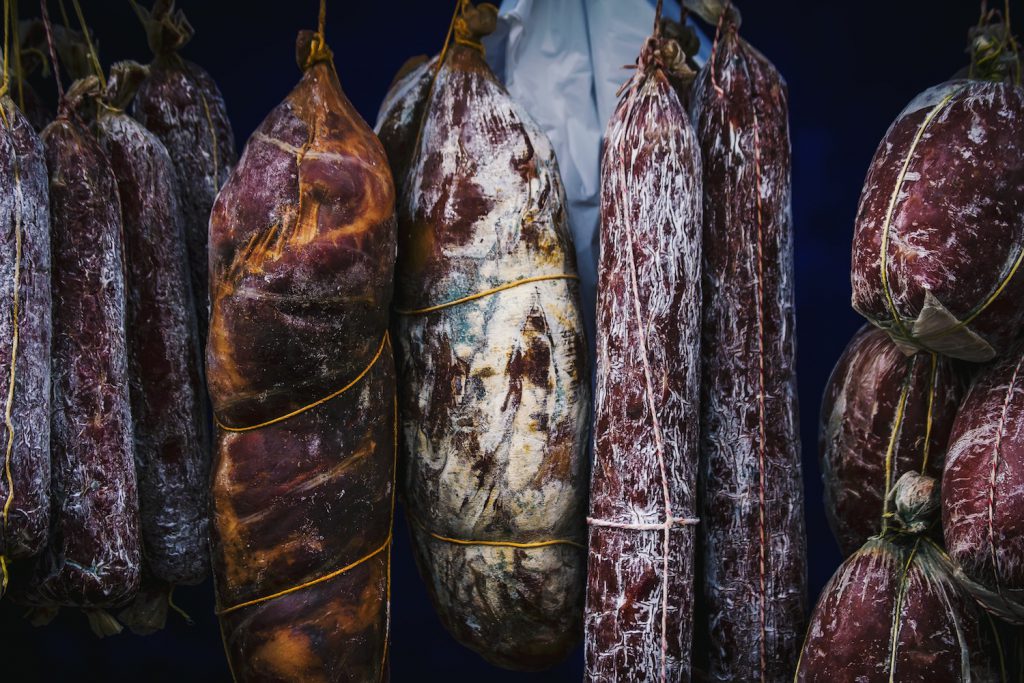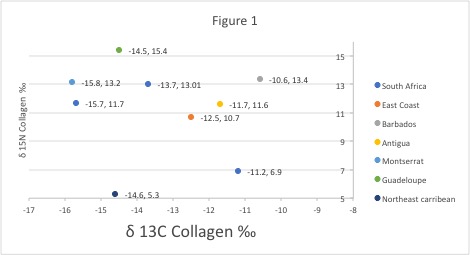Diet Reconstruction of Enslaved Peoples in the New and Old Worlds
by Grant M. Sherwood
This study examines the hypothesis that populations of enslaved individuals received different diets based on the level of democratization in that area. To examine this hypothesis, data was gathered from several bioarchaeologists who worked in areas from South Africa to the East Coast of North America. Through stable isotope data gathered from these studies, general diet information was interpreted to test the hypothesis. Through comparing these countries, it could be established whether there was a relationship between democracy in a nation and diet. The data showed that there was a large amount of variability in the diets of enslaved individuals in different communities. Even within the same country, such as South Africa, these was drastic differences in diet. This demonstrated that the presence of democracy did not affect the diets of enslaved individuals within the country. Stable isotope data was then compared to historical documents and first-hand accounts of food to confirm the data collected. Each location was then analyzed to establish the reasons for diet variation in the context of democratization. It was determined that the difference between these location’s diets was due to individual discretion of the land owners and not democratization. Areas that were closer to the water had high levels of nitrogen indicating increased marine life consumption. Through this, it was discovered that there was little relationship between democratization and diet quality. This is because of the relatively poor diets that were present in both democratic and non-democratic nations.
Introduction
Human lifestyle and diet are complicated topics to broach, whether working within the scope of biology or from the perspective of an anthropologist. This paper will focus on reconstructing the diets of enslaved people and on determining whether democratization in countries plays a role in the quality of their diets. I will examine this dynamic topic more specifically in the context of enslaved people in past societies from South Africa to the East Coast of the United States. I will use a combination of human remains, faunal remains, and first-hand accounts to analyze the subjective diets of enslaved people in different areas of the New World and Old World. These sources allow for multiple perspectives and supporting data to provide a sound framework for the ideas in this study. I will also pursue the reason behind regional variations of slaves’ diets. For example, were the slaves in past societies fed well to preserve their strength, or could poor treatment have been used to save money on food and essentials for slave owners? Through similar questions, I will attempt to investigate the underlying reasons for slaves’ treatment and to analyze them within the context of slaves’ daily lives.
There is no doubt that an enslaved person’s life was filled with hardship and strife, researchers and archaeologists know little about his or her diet. Researchers such as Linda Mbeki and Diana Crader have delved into the reconstruction of slaves’ diets. Their interest in the subject has generated studies on several locations ranging from the New World to Old World, focusing on the East Coast, Eastern Caribbean, and South Africa. In South Africa, Mbeki looked at the stable isotope ratios of skeletal remains from enslaved individuals in Green Point, South Africa. She found higher values of δ13C collagen and δ15N collagen, indicating a possible increased dependence on marine life due to price and availability (Mbeki 2016). This indicates decreased access to other food due to enslavement. Other researchers studying faunal remains on the East Coast found that certain groups of enslaved people enjoyed a fairly good diet: “This suggests that the existence of status and social stratification within the slave community can be documented in faunal remains,” (Crader 1990, p. 714). The assertion contradicted many of Mbeki’s conclusions. I will examine the impact of location on slaves’ diets to determine the reason behind these discrepancies.
Methodological Background
Many researchers and bioarchaeologists attempt to navigate the many factors that play into diet reconstruction and try to glean some information on the social aspect of slave communities. Generally, reconstructing diets is accomplished through a combination of tooth analysis, faunal remain analysis, and stable isotope analysis. I will utilize all three of these strategies to analyze slave’s diets.
The most widely used reconstruction method, stable isotope analysis, involves the analysis of atoms in skeletal remains. Varying abundances of variants of atoms (isotopes) in bones and teeth allow for a general idea as to the types of food an individual might have consumed during his or her life. For example, a fish-based diet would cause an increased nitrogen isotope ratio, while a corn-based diet would have elevated carbon isotope ratios and decreased nitrogen isotope ratios. These general ideas can be applied to inferences on the diet of groups and individuals themselves (Pearson 2013; Varney 2004).
Analysis of tooth wear and dental disease is another method for diet reconstruction. For example, a population with a high prevalence of dental caries could indicate a diet high in sugar. Evidence like this can give bioarchaeologists an idea as to the dental health and diet type of certain populations.
When reconstructing diets, bioarchaeologists can also look into faunal remains, which can reveal the butchering practices of these populations (Crader 1990). Faunal remains can assist in diet reconstruction by specifying which animals (and which animal parts) were eaten. For example, if a household had primarily cow bones from legs or shoulders, it would indicate that the household ate from those portions of the animal.
These methods allow for a more in-depth look at past populations’ diets and give researchers a good idea of the analyzed populations’ health. Due to the small amount of data on dental health from these slave populations, I will focus on isotope analysis for diet reconstruction. The stable isotope data will help to determine whether the differing levels of democratization correlate with diet patterns in slaves.
Historical Background
Research reconstructing the diets of enslaved African Americans continues to grow, and what research has been conducted provides in-depth analyses of diet. In Herbert Covey’s look at diets of enslaved people in the U.S. South, he explains the evolution of diet within the Americas as well as the dynamic nature of food sources. He gleans this information from slaves’ own first-hand accounts and not from owners and slave traders. The data are supported by researchers like Tamera Varney, who determined that enslaved people subsided primarily on grains during their transport through the middle passage (Varney 2004). However, when they arrived at the New World their diet consisted mostly of vegetables with little to no meat. Varney argues that, due to this, at least during the early portions of slavery, enslaved persons were often healthier than their masters, whose diet consisted mostly of meat (Covey 2009). This quality slowly decreased as slavery expanded in the New World, and the diets of slaves were limited further by decreases in variety.
Covey does establish that, throughout the majority of the slave trade in the U.S. South, slaves survived on products from their own hunting and farming. This trend, owing to the lack of food their owners made available to them, persisted throughout the entire existence of slavery within the Americas (Covey 2009). Hunting and farming assisted in creating a diet with more variety and greater nutritional value. Other researchers like Mbeki have similarly concluded that enslaved people subsidized their diets with locally available food. Through isotope analysis, Mbeki concludes that enslaved people ate large amounts of marine based foods in Green Point (Mbeki 2016).
The presence of some self-sustaining slave groups around the world shows the place slaves held in democratic and non-democratic nations. Even within nations preaching equal treatment like the United States, slaves as a social class were held in low regard. In a nation that promoted the idea that “all men were created equal,” there was considerable mistreatment and deplorable actions towards enslaved individuals. One can see this mistreatment in the data retrieved, in which slaves were not fed or treated adequately. So, these enslaved groups had to use local wildlife and farming to stay alive. These practices do not reflect the ideals that were originally put forth by the U.S. Constitution, as slaves received similar treatment in countries less democratic than the United States. Also, various cuts of meat in different slave residences could indicate dietary differences within populations (Crader 2018).
Researchers such as Crader have alternatively argued that faunal remains suggest that enslaved people and their owners ate similar diets. In her study on faunal remains at Monticello, Crader discusses the large quantities of good cuts of meat found in the remains of certain slave residences. Crader proposes that these remnants of remains show a social hierarchy within the enslaved community.
Methods
I will have to employ several methods of analysis to discover whether democratization plays a role in slave diets. I compiled data from various sources; I primarily used δ15N collagen and δ13C collagen data, retrieved from bone samples and teeth samples, to consider diet information. I included the standard deviation in parentheses, so that the spread of the data can be understood. I then compared these averages to existing measurements of δ15N collagen and δ13C collagen to see the prevalence of C4 and C3 plants in their diets. I also used them to look at consumption of fish and other meats.
The first set of data that I will analyze is from researchers Dent and Cox, who examine diet reconstruction in Cape Town, South Africa. Next, I will compare Mbeki’s look into diet in similar regions of South Africa with the data Cox presented. These data sets will allow for diet approximations of slaves within South Africa. These diet approximations will also give a baseline to compare to other plantations around the New World.
I will then analyze the East Coast sites, like Monticello, to look for similarities and differences that exist between South Africa and the East Coast. I will contrast these with data collected from Vanderpool and Varney along with the analysis conducted by Dent. These three regions will provide a basis for comparison among these different regions so that I can put together a composite picture of slave diets. Overall, comparing and contrasting the data from these different researchers will help to narrow down the answer to whether democratization plays a role in slave diets.
Analysis and Results
While there are isotopic studies for adolescents and children within several papers, I will focus on adults in this analysis. This is because the isotopic levels in children change drastically after weaning, and this can skew the data drastically.
First, Dent’s paper looks at the reconstruction of diet in 18th and 19th century slave populations. She covers several regions, one of which is South Africa. Dent uses Cox’s data retrieved from Cape Town to analyze these different regions. For study A, the remains were determined to be from 1818, while for study B it ranged between the eighteenth and nineteenth centuries (Cox et. al 2001; Cox and Sealy 1997; Dent 2016).
The data collected from South Africa show that there was a mix of C4 and C3 plants, but their diet primarily contained C4 plants like maize. Mbeki used 54 burials for her South African study, and almost all of them were determined to be adults (age estimation was not possible from some remains). However, the range for this data set was much larger, with Carbon values ranging from -6.6‰ to -20.3‰ and Nitrogen values ranging from 7.1‰ to 16.5‰. The large range in this data suggests that there was a wide variety of diets in this area. This larger range did affect the overall averages, but the majority of the data was clustered around δ15N collagen 14.0‰ and δ13C collagen -15.0‰ (Chart 1; Figure 1; Mbeki 2016). A similar trend occurred in Cox’s set of data, with most of the population consuming large amounts of C4 plants. The only difference in Cox’s data was an increase in consumption of marine food sources that increased the Nitrogen levels. These different averages indicate that enslaved individuals in study A were fed a cheap C4-based diet, while enslaved individuals in study B consumed a much more diverse diet based on seafood.
The next location is the U.S. East Coast in South Carolina, which Dent analyzed from the adult portion of her study (Chart 1; Figure 1; Dent 2016; Schroeder 2009; Vanderpool 2013). This site resulted in heavy consumption of C4 plants as a primary source of nutrition for the slaves residing in South Carolina. This study continues to follow the trend of Cox’s study A, in which there was a primarily corn-based diet. Crader’s study focused on faunal remains at the Monticello site, so no stable isotope analysis was conducted at this site. However, Crader discusses the analysis of faunal assemblages at the Monticello site, which indicate differing levels of high-quality meat consumption between different slave quarters.
Finally, several isotope analyses were done on populations in the Caribbean, with data collected from Barbados, Antigua, Montserrat, and Guadeloupe. Authors Tamara Varney and Dent conducted extensive work on remains found within this region. Two tests were conducted from Dent’s data set, one at Barbados and one in the Northeast Caribbean (Chart 1; Dent 2016; Vanderpool 2013). These data show that C4 plants still predominated slaves’ diets, though with increased marine-life consumption in this case. This increased marine consumption can be attributed to the location of these sites, in which fish and other food are readily available. Varney’s dissertation specifically focuses on Antigua, Montserrat, and Guadeloupe.
This data set, unlike the U.S. and South Africa, was the most dynamic of all. At Antigua and Guadeloupe, there were large amounts of marine-life consumption and decreased values of δ13C collagen in most of the diets. However, Montserrat proved to be the most unique, with the highest values of C3 plants from any site; furthermore, there was still consumption of C4 and marine life. The variety of diets from these islands shows that there are differences in the slaves’ diets on different islands. However, it is still unclear as to why they are different and whether these differences are due to the effect of democratization in these areas.
Source: Average δ15N collagen and δ13C collagen in slaves in different regions, Figure created by Grant Sherwood. Data retrieved from: Cox et. al 2001, Cox and Sealy 1997, Dent 2016, Mbeki 2016, Schroeder 2009, and Vanderpool 2013.
| Chart 1 | δ15C collagen | δ13N collagen |
| South Africa (Cox A) | -11.2 | 6.9 |
| South Africa (Cox B) | -15.7 | 11.7 |
| South Africa (Mbeki) | -13.7 | 13.01 |
| East Coast | -12.5 | 10.7 |
| Barbados | -10.6 | 13.4 |
| Antigua | -11.7 | 11.6 |
| Mont Serrat | -15.8 | 13.2 |
| Guadeloupe | -14.5 | 15.4 |
| Northeast Caribbean | -14.6 | 5.3 |
Source: Average δ15N collagen and δ13C collagen in slaves in different regions, chart created by Grant Sherwood. Data retrieved from: Cox et. al 2001, Cox and Sealy 1997, Dent 2016, Mbeki 2016, Schroeder 2009, and Vanderpool 2013.
Discussion
There was a large presence of C4 plants in the diet in all of the groups from the collected data, from South Africa to South Carolina. The prevalence of C4 based diets is supported by the first-hand reports from Covey’s interviews (Covey 2009). This shows that the first-hand accounts reflect the results of the analysis; however, it also means that there was likely no change in diets between regions. The prevalence of C4 plants in almost all of the sites suggests this (Cox and Sealy 1997; Dent 2016; Mbeki 2016; Varney 2004). The only place that showed a balance of C3 plants, C4 plants, and marine life consumption was Montserrat. This outlier had the most diverse diet of any of the other locations analyzed, with results dramatically different from the other islands in the area. The diet of this island, however, is explained by the large amount of volcanic activity that limits the farmland on the island. This means that there are larger amounts of meat consumption, which could explain this large disparity.
For the rest of the data, this increase of C4 could have several possible explanations. First, the majority of slaveholders may have fed their slaves poorly, and the wide spread consumption of C4 plants could reflect this. C4 plants (corn, sugar cane, etc.) are generally more resilient to drought and difficult weather conditions. For example, maize was fairly easy to grow in many different climates, which would indicate decreased market prices due to its abundance. A low market price would have made buying large amounts for slaves much more cost-efficient than supplying them with such produce as rice, which was not as easily cultivated in these areas. This is also supported by the largescale maize agriculture in the Americas during this period. If this analysis is correct it could indicate a that democratization did not play a significant role in slaves’ diets and that there were not regional differences in treatment.
Second, it is possible that the slaves in these locations could have received a fairly balanced diet within the broad scope of C4 plants. This would indicate that the slave populations received more than the bare essentials. This assertion, however, is fairly unlikely, considering the first-hand reports of slave conditions and the fact that their enslavement itself suggests that they were not fed adequately.
This data analysis demonstrates the actual relationship of democracy and enslavement. For example, of all the locations only the U.S. was a democracy during the enslavement of these individuals. However, in almost every example used, the diet and treatment of these slaves remained similar. Their diet was composed of mostly C4 plants (Dent 2016; Mbeki 2016). Even Crader’s study on faunal assemblages at Monticello showed that most slaves ate little to no meat. When meat was present in their diet, it was primarily lower-quality meat from the worst parts of the animals, probably leftovers from the slaveowners. She also states that, even in the lodgings that showed better cuts of meat being used, “whether it is associated directly with the slaves is a question that remains” (Crader 2018). This is an example of the contradictions that existed in democracy during this period. Even seemingly democratic nations functioned as non-democratic ones. That slaves held a place in the social hierarchy suggests the role that slavery played in the development of practicing democratic principles.
Conclusion
I gleaned a great deal of data from each of these sources, all of which provided a glimpse into the diets of the slaves present at these various locations around the world. The data sets allow us to consider the social relationship between slaves and their owners and to view their treatment through diet. This perspective also allows us to consider the social interactions between these two groups, including the distribution of power.
From the data collected, it is apparent that there were not widespread regional differences in slaves’ diets. The only minor differences in diet were within the Caribbean (Varney 2004). These can be attributed to the availability of fish in certain areas and not to the change in slaveowners’ provisioning food for slaves. In addition, some islands like Barbados even showed little marine-life consumption, which illustrates the similarities between these sites.
These results suggest that a majority of enslaved groups were fed poorly by their owners. Moreover, the hypothesis that owners fed slaves well to promote better work is not supported. This gives researchers an idea as to what slaves’ lifestyles were like during this period as well as the hardships that they endured.
The data expose a lack of democratic principles even in democratic states, such as the U.S. in the eighteenth and nineteenth centuries. During this period, they functioned somewhat similarly to states like South Africa and Barbados, which did not become fully democratic until the late twentieth century. The act of democratization continued within the United States long after the Declaration of Independence was signed. Even within nations with democratic principles, slavery and mistreatment of what they considered “property” still occurred. Democratization is a long process of working toward equal rights and equal representation.
References
Covey, H. C., & Eisnach, D. (2009). What the slaves ate: Recollections of African American foods and foodways from the slave narratives. Santa Barbara, CA: Greenwood Press.
Cox, G., & Sealy, J. (1997). Investigating identity and life histories: Isotopic analysis and historical documentation of slave skeletons found on the Cape Town foreshore, South Africa. International Journal of Historical Archaeology, 1(3), 207–224.
Cox, G., Sealy, J., Schrire, C., & Morris, A. (2001). Stable carbon and nitrogen isotopic analyses of the underclass at the colonial Cape of Good Hope in the eighteenth and nineteenth centuries. World Archaeology, 33(1), 73–97.
Crader, D. C. (1990). Slave diet at Monticello. American Antiquity, 55(4), 690–717.
Dent, S. C. (2016). Interindividual differences in embodied marginalization: osteological and stable isotope analyses of antebellum enslaved individuals. American Journal of Human Biology, 1-16.
Mbeki, L., Kootker, L. M., Kars, H., & Davies, G. R. (2016). Sickly slaves, soldiers and sailors. contextualising the Cape’s 18th–19th century Green Point burials through isotope investigation. Journal of Archaeological Science, 11, 480-490.
Pearson, J., & Grove, M. (2013). Counting sheep: sample size and statistical inference in stable isotope analysis and palaeodietary reconstruction. World Archaeology, 45, 373-387
Schroeder, H., O’connell, T. C., Evans, J. A., Shuler, K. A., & Hedges, R. E. (2009). Trans-Atlantic slavery: Isotopic evidence for forced migration to Barbados. American Journal of Physical Anthropology, 139(4), 547–557.
Vanderpool, E. M., & Turner, B. L. (2013). Stable isotopic reconstruction of diet and residential mobility in a postbellum African American com- munity in rural Georgia. Southeastern Archaeology, 32(1), 97–110.
Varney, T. L. (2004). Reconstructing diet and tracing life histories in colonial populations of the northeastern Caribbean using stable carbon and nitrogen isotopes. Dissertation Abstracts International, 65, 201.
Acknowledgements: To my parents, who have inspired me to follow my dreams.
Citation style: AJPA
. . . . . . . . . . Return to the Table of Contents.




